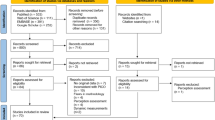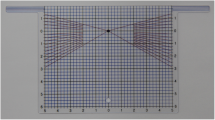Abstract
Background
Although perioral aging is highly individual with several distinct processes taking part simultaneously, there is scarce systematic information which helps to indicate the right rejuvenation approach among the multitude of proposed procedures. Existing data about perioral aging has not yet been transformed into a consistent therapeutic concept. The intention of this study was to provide a simple, yet reproducible classification and to offer appropriate rejuvenation approaches.
Methods
To identify reliable and constant landmarks of the ongoing process of perioral aging, 462 perioral photo documentations were morphometrically analyzed. Based upon the identified landmarks a two-dimensional classification was developed. The classification was validated by three plastic surgeons. Inter- and intra-rater reliability was calculated using Cohen’s kappa coefficient.
Results
Perioral aging can be broken down into changes of the lip shape and changes of the lip surface. Both processes can be classified into three stages each: Lip shape according to the shape in profile view, the lip length in relation to the frontal incisors, and the degree of vermilion inversion. Lip surface according to the presence and degree of radial wrinkles and the visibility of the structural elements Cupid’s bow, philtrum, and white roll. Inter-observer reliability was rated very good (kappa values between 0.819 and 0.963) and perfect for intra-observer reliability (1.0).
Conclusion
A better understanding of perioral aging leads to a simple classification for the aging lips. Using the classification helps to tailor an appropriate treatment to the individual patient and aids to achieve a natural rejuvenation result.
Level of Evidence IV
This journal requires that authors assign a level of evidence to each article. For a full description of these Evidence-Based Medicine ratings, please refer to the Table of Contents or the online Instructions to Authors www.springer.com/00266.





Similar content being viewed by others
References
Penna V et al (2009) The aging lip: a comparative histological analysis of age-related changes in the upper lip complex. Plast Reconstr Surg 124(2):624–628
Iblher N et al (2008) Changes in the aging upper lip–a photomorphometric and MRI-based study (on a quest to find the right rejuvenation approach). J Plast Reconstr Aesthet Surg 61(10):1170–1176
Sforza C et al (2010) Age- and sex-related changes in three-dimensional lip morphology. Forensic Sci Int 200(1–3):182 e1–7
Penna V et al (2010) Proving the effectiveness of the lip lift for treatment of the aging lip: a morphometric evaluation. Plast Reconstr Surg 126(2):83e–84e
Cohen SR et al (2006) ArteFill: a long-lasting injectable wrinkle filler material–summary of the U.S. Food and Drug Administration trials and a progress report on 4- to 5-year outcomes. Plast Reconstr Surg 118(3 Suppl):64S–76S
Jacono AA (2008) A new classification of lip zones to customize injectable lip augmentation. Arch Facial Plast Surg 10(1):25–29
Sclafani AP (2005) Soft tissue fillers for management of the aging perioral complex. Facial Plast Surg 21(1):74–78
Thaler MP, Ubogy ZI (2005) Artecoll: the Arizona experience and lessons learned. Dermatol Surg 31(11 Pt 2): 1566-1574; discussion 1575–1576
Wise JB, Greco T (2006) Injectable treatments for the aging face. Facial Plast Surg 22(2):140–146
Kridel RW (2001) Acellular human dermis for facial soft tissue augmentation. Facial Plast Surg Clin North Am 9(3):413–437
Gryskiewicz JM (2000) Alloderm lip augmentation. Plast Reconstr Surg 106(4):953–954
Moscona RA, Fodor L (2009) A retrospective study on liquid injectable silicone for lip augmentation: long-term results and patient satisfaction. J Plast Reconstr Aesthet Surg 63(10):1694–1698
Verret DJ, Leach JL, Gilmore J (2006) Dual-porosity expanded polytetrafluoroethylene implants for lip, nasolabial groove, and melolabial groove augmentation. Arch Facial Plast Surg 8(6):423–425
Semchyshyn N, Sengelmann RD (2003) Botulinum toxin A treatment of perioral rhytides. Dermatol Surg 29(5):490–495; discussion 495
Lowe NJ, Yamauchi P (2004) Cosmetic uses of botulinum toxins for lower aspects of the face and neck. Clin Dermatol 22(1):18–22
Langsdon PR, Milburn M, Yarber R (2000) Comparison of the laser and phenol chemical peel in facial skin resurfacing. Arch Otolaryngol Head Neck Surg 126(10):1195–1199
Dijkema SJ, van der Lei B (2005) Long-term results of upper lips treated for rhytides with carbon dioxide laser. Plast Reconstr Surg 115(6):1731–1735
Rozner L, Isaacs GW (1981) Lip lifting. Br J Plast Surg 34(4):481–484
Pitanguy I et al (1987) Esthetic surgery of the aging lip. Compendium 8(6):460–463, 465
Hinderer UT (1995) Aging of the upper lip: a new treatment technique. Aesthetic Plast Surg 19(6):519–526
Guerrissi JO, Sanchez LI (1993) An approach to the senile upper lip. Plast Reconstr Surg 92(6):1187–1191
Fanous N (1984) Correction of thin lips: “lip lift”. Plast Reconstr Surg 74(1):33–41
Austin HW (1986) The lip lift. Plast Reconstr Surg 77(6):990–994
Santanche P, Bonarrigo C (2004) Lifting of the upper lip: personal technique. Plast Reconstr Surg 113(6):1828–1835; discussion 1836–1837
Felman G (1993) Direct upper-lip lifting: a safe procedure. Aesthetic Plast Surg 17(4):291–295
Altman DG (1991) Practical Statistics for Medical Research. Chapman & Hall/CRC, Boca Raton
Landis JR, Koch GG (1977) The measurement of observer agreement for categorical data. Biometrics 33(1):159–174
Kane MA et al (2012) Validation of a lip fullness scale for assessment of lip augmentation. Plast Reconstr Surg 129(5):822e–828e
Wollina U (2013) Perioral rejuvenation: restoration of attractiveness in aging females by minimally invasive procedures. Clin Interv Aging 8:1149–1155
Loose NA, et al (2014) Anatomy and lip enhancement. E2e Master collection. vol 4. E2e Medical Publishing, Paris
Solish N, Swift A (2011) An open-label, pilot study to assess the effectiveness and safety of hyaluronic acid gel in the restoration of soft tissue fullness of the lips. J Drugs Dermatol 10(2):145–149
Trelles MA, Shohat M, Urdiales F (2011) Safe and effective one-session fractional skin resurfacing using a carbon dioxide laser device in super-pulse mode: a clinical and histologic study. Aesthetic Plast Surg. 35(1):31–42
Suryadevara AC (2008) Update on perioral cosmetic enhancement. Curr Opin Otolaryngol Head Neck Surg 16(4):347–351
Perkins SW, Balikian R (2007) Treatment of perioral rhytids. Facial Plast Surg Clin North Am 15(4):409–414 v
Recupero WD, McCollough EG (2010) Comparison of lip enhancement using autologous superficial musculoaponeurotic system tissue and postauricular fascia in conjunction with lip advancement. Arch Facial Plast Surg 12(5):342–348
Leaf N, Firouz JS (2002) Lip augmentation with superficial musculoaponeurotic system grafts: report of 103 cases. Plast Reconstr Surg 109(1):319–326; discussion 327–328
Citarella ER, Sterodimas A, Conde-Green A (2009) Lip rejuvenation using perioral myotomies and orbicularis oculi muscle as autologous filler. Plast Reconstr Surg 124(6):446e–448e
Cartier H et al (2012) Perioral rejuvenation with a range of customized hyaluronic acid fillers: efficacy and safety over six months with a specific focus on the lips. J Drugs Dermatol 11(1 Suppl):s17–s26
Fagien S (1999) Botox for the treatment of dynamic and hyperkinetic facial lines and furrows: adjunctive use in facial aesthetic surgery. Plast Reconstr Surg 103(2):701–713
Carruthers J, Carruthers A (2004) Botulinum toxin A in the mid and lower face and neck. Dermatol Clin 22(2):151–158
Kaplan SE et al (2007) The use of botulinum toxin A in perioral rejuvenation. Facial Plast Surg Clin North Am 15(4):415–421 v–vi
Carruthers A et al (2010) Multicenter, randomized, parallel-group study of the safety and effectiveness of onabotulinumtoxinA and hyaluronic acid dermal fillers (24-mg/ml smooth, cohesive gel) alone and in combination for lower facial rejuvenation. Dermatol Surg 36(Suppl 4):2121–2134
Ascher B et al (2010) International consensus recommendations on the aesthetic usage of botulinum toxin type A (Speywood Unit)–Part II: Wrinkles on the middle and lower face, neck and chest. J Eur Acad Dermatol Venereol 24(11):1285–1295
Kane MA (2005) Botox injections for lower facial rejuvenation. Oral Maxillofac Surg Clin North Am 17(1):41–49 vi
Klein AW (2004) Contraindications and complications with the use of botulinum toxin. Clin Dermatol 22(1):66–75
Lehrer MS, Benedetto AV (2005) Botulinum toxin—an update on its use in facial rejuvenation. J Cosmet Dermatol 4:285–297
Lanigan S (2011) An observational study of a 24 mg/mL hyaluronic acid with pre-incorporated lidocaine for lip definition and enhancement. J Cosmet Dermatol 10(1):11–14
Scarano A, Carinci F, Piattelli A (2009) Lip augmentation with a new filler (agarose gel): a 3-year follow-up study. Oral Surg Oral Med Oral Pathol Oral Radiol Endod 108(2):e11–e15
De Boulle K et al (2009) Lip augmentation and contour correction with a ribose cross-linked collagen dermal filler. J Drugs Dermatol 8(3 Suppl):1–8
Carruthers J et al (2010) Multicenter, randomized, parallel-group study of onabotulinumtoxinA and hyaluronic acid dermal fillers (24-mg/ml smooth, cohesive gel) alone and in combination for lower facial rejuvenation: satisfaction and patient-reported outcomes. Dermatol Surg 36(Suppl 4):2135–2145
Trussler AP et al (2008) Upper lip augmentation: palmaris longus tendon as an autologous filler. Plast Reconstr Surg 121(3):1024–1032
Mojallal A et al (2009) Improvement of skin quality after fat grafting: clinical observation and an animal study. Plast Reconstr Surg 124(3):765–774
Christensen L et al (2005) Adverse reactions to injectable soft tissue permanent fillers. Aesthetic Plast Surg 29(1):34–48
Lombardi T et al (2004) Orofacial granulomas after injection of cosmetic fillers. Histopathologic and clinical study of 11 cases. J Oral Pathol Med 33(2):115–120
Wolfram D, Tzankov A, Piza-Katzer H (2006) Surgery for foreign body reactions due to injectable fillers. Dermatology 213(4):300–304
Andre P et al (2005) Adverse reactions to dermal fillers: a review of European experiences. J Cosmet Laser Ther 7(3–4):171–176
Magne P, Gallucci GO, Belser UC (2003) Anatomic crown width/length ratios of unworn and worn maxillary teeth in white subjects. J Prosthet Dent 89(5):453–461
Acknowledgments
The authors would like to thank Saskia Manegold for assistance with graphical illustration. This research received no specific grant from any funding agency in the public, commercial, or not-for-profit sectors. The authors declare that they have no conflicts of interest to disclose.
Author information
Authors and Affiliations
Corresponding author
Rights and permissions
About this article
Cite this article
Penna, V., Stark, G.B., Voigt, M. et al. Classification of the Aging Lips: A Foundation for an Integrated Approach to Perioral Rejuvenation. Aesth Plast Surg 39, 1–7 (2015). https://doi.org/10.1007/s00266-014-0415-2
Received:
Accepted:
Published:
Issue Date:
DOI: https://doi.org/10.1007/s00266-014-0415-2




